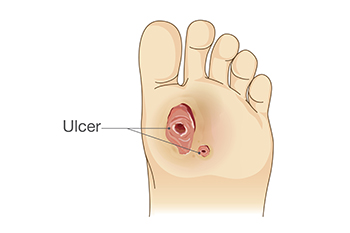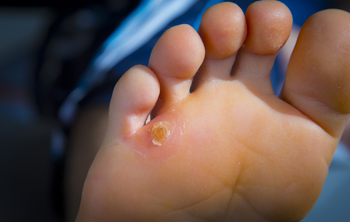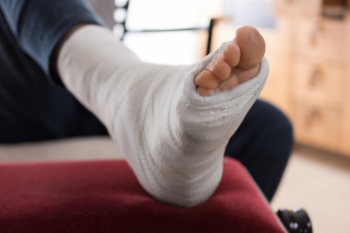Items filtered by date: June 2025
Podiatric Care for Ankle Sprains

An ankle sprain occurs when the ligaments that support the ankle stretch or tear, usually due to sudden twisting or rolling of the foot. Inversion sprains happen when the foot rolls inward, affecting the outer ligaments, while eversion sprains involve the foot rolling outward, impacting the inner ligaments. Common causes include sports injuries, uneven surfaces, or missteps. Symptoms include pain, swelling, bruising, and limited mobility. Among the risk factors are poor footwear, weak ankle muscles, and previous sprains. A podiatrist can assess the severity of the sprain, provide imaging, if needed, and develop a treatment plan that may include rest, bracing, or specific stretches and exercises. If you experience ankle pain or instability, it is suggested that you consult a podiatrist for expert care and recovery guidance.
Although ankle sprains are common, they aren’t always minor injuries. If you need your ankle injury looked at, contact Susan Yeager, DPM from Yeager Foot and Ankle Center. Our doctor can provide the care you need to keep you pain-free and on your feet.
How Does an Ankle Sprain Occur?
Ankle sprains are the result of a tear in the ligaments within the ankle. These injuries may happen when you make a rapid shifting movement while your foot is planted. A less common way to sprain your ankle is when your ankle rolls inward while your foot turns outward.
What Are the Symptoms?
- Pain at the sight of the tear
- Bruising/Swelling
- Ankle area is tender to touch
- In severe cases, may hear/feel something tear
- Skin discoloration
Preventing a Sprain
- Wearing appropriate shoes for the occasion
- Stretching before exercises and sports
- Knowing your limits
Treatment of a Sprain
In many cases, the RICE method (Rest, Ice, Compression, and Elevate) is used to treat ankle sprains. However, you should see a podiatrist to see which treatment option would work best with your injury. In severe cases, surgery may be required.
It is important to ask your doctor about rehab options after you receive treatment for your injury. Stretching, strength training, and balance exercises may help the ankle heal while also preventing further injury.
If you have any questions, please feel free to contact our office located in Redding, CA . We offer the newest diagnostic and treatment technologies for all your foot care needs.
Diabetic Foot Ulcers and Podiatric Care

Diabetic foot ulcers are open wounds or sores that typically develop on the bottom of the foot in diabetics. They are caused by a combination of poor circulation, nerve damage, and repetitive pressure or injury to the foot. Risk factors include long-term diabetes, smoking, poorly controlled blood sugar, and improper footwear. Symptoms may include redness, swelling, drainage, or a foul odor. These ulcers can become infected and lead to serious complications. A podiatrist plays a key role in managing diabetic foot ulcers by providing wound care, pressure relief, and guidance on foot hygiene. If you have diabetes, it is strongly suggested that regular visits to a podiatrist are part of a routine plan that can help you to manage existing foot ulcers.
Wound care is an important part in dealing with diabetes. If you have diabetes and a foot wound or would like more information about wound care for diabetics, consult with Susan Yeager, DPM from Yeager Foot and Ankle Center. Our doctor will assess your condition and provide you with quality foot and ankle treatment.
What Is Wound Care?
Wound care is the practice of taking proper care of a wound. This can range from the smallest to the largest of wounds. While everyone can benefit from proper wound care, it is much more important for diabetics. Diabetics often suffer from poor blood circulation which causes wounds to heal much slower than they would in a non-diabetic.
What Is the Importance of Wound Care?
While it may not seem apparent with small ulcers on the foot, for diabetics, any size ulcer can become infected. Diabetics often also suffer from neuropathy, or nerve loss. This means they might not even feel when they have an ulcer on their foot. If the wound becomes severely infected, amputation may be necessary. Therefore, it is of the upmost importance to properly care for any and all foot wounds.
How to Care for Wounds
The best way to care for foot wounds is to prevent them. For diabetics, this means daily inspections of the feet for any signs of abnormalities or ulcers. It is also recommended to see a podiatrist several times a year for a foot inspection. If you do have an ulcer, run the wound under water to clear dirt from the wound; then apply antibiotic ointment to the wound and cover with a bandage. Bandages should be changed daily and keeping pressure off the wound is smart. It is advised to see a podiatrist, who can keep an eye on it.
If you have any questions please contact our office located in Redding, CA . We offer the newest diagnostic and treatment technologies for all your foot and ankle needs.
Causes and Types of Corns

Corns are thickened areas of skin that develop in response to repeated pressure or friction, often from wearing ill-fitting shoes or abnormal walking patterns. They typically form on the tops and sides of toes or on the soles of the feet. Common causes include wearing tight footwear, high heels, or walking without proper support. There are different types of corns, including hard corns, soft corns found between the toes, and seed corns which appear on the bottom of the foot. While small corns may not cause pain, larger ones can become uncomfortable or lead to further irritation. A podiatrist can identify the cause, safely remove corns, and recommend footwear or custom orthotics to relieve pressure and prevent recurrence. If you have developed a corn, it is suggested that you confer with a podiatrist who can offer effective relief and treatment solutions.
Corns can make walking very painful and should be treated immediately. If you have questions regarding your feet and ankles, contact Susan Yeager, DPM of Yeager Foot and Ankle Center. Our doctor will treat your foot and ankle needs.
Corns: What Are They? And How Do You Get Rid of Them?
Corns are thickened areas on the skin that can become painful. They are caused by excessive pressure and friction on the skin. Corns press into the deeper layers of the skin and are usually round in shape.
Ways to Prevent Corns
There are many ways to get rid of painful corns such as:
- Wearing properly fitting shoes that have been measured by a professional
- Wearing shoes that are not sharply pointed or have high heels
- Wearing only shoes that offer support
Treating Corns
Although most corns slowly disappear when the friction or pressure stops, this isn’t always the case. Consult with your podiatrist to determine the best treatment option for your case of corns.
If you have any questions, please feel free to contact our office located in Redding, CA . We offer the newest diagnostic and treatment technologies for all your foot care needs.
Keep Your Feet Healthy So You Can Stay Active
Understanding Reconstructive Foot Surgery

Reconstructive foot surgery is performed to restore the shape and function of the foot when bones, joints, or soft tissues have been damaged due to trauma, disease, or deformity. Common causes include serious injuries, birth defects like clubfoot, infections, or complications from diabetes and vascular disease. A podiatrist may recommend reconstructive foot surgery when the anatomy of the foot is severely affected and conservative options are no longer effective. Procedures may involve removal of dead or infected tissue, skin grafts, or the use of tissue flaps that include skin, muscle, or bone. Tendon transfers and lengthening may be used to improve foot movement. In some cases, loss of limb may be discussed when reconstruction is not appropriate. Not everyone is a candidate for this surgery, particularly those with widespread infection, severe circulation problems, or poor overall health. A podiatrist can help determine whether surgery is appropriate and explain the options. If you are a candidate for reconstructive foot surgery, it is suggested that you schedule an appointment with a podiatrist for an exam and treatment options.
Foot surgery is sometimes necessary to treat a foot ailment. To learn more, contact Susan Yeager, DPM of Yeager Foot and Ankle Center. Our doctor will assist you with all of your foot and ankle needs.
When Is Surgery Necessary?
Foot and ankle surgery is generally reserved for cases in which less invasive, conservative procedures have failed to alleviate the problem. Some of the cases in which surgery may be necessary include:
- Removing foot deformities like bunions and bone spurs
- Severe arthritis that has caused bone issues
- Cosmetic reconstruction
What Types of Surgery Are There?
The type of surgery you receive will depend on the nature of the problem you have. Some of the possible surgeries include:
- Bunionectomy for painful bunions
- Surgical fusion for realignment of bones
- Neuropathy decompression surgery to treat nerve damage
Benefits of Surgery
Although surgery is usually a last resort, it can provide more complete pain relief compared to non-surgical methods and may allow you to finally resume full activity.
Surgical techniques have also become increasingly sophisticated. Techniques like endoscopic surgery allow for smaller incisions and faster recovery times.
If you have any questions, please feel free to contact our office located in Redding, CA . We offer the newest diagnostic and treatment technologies for all your foot care needs.

